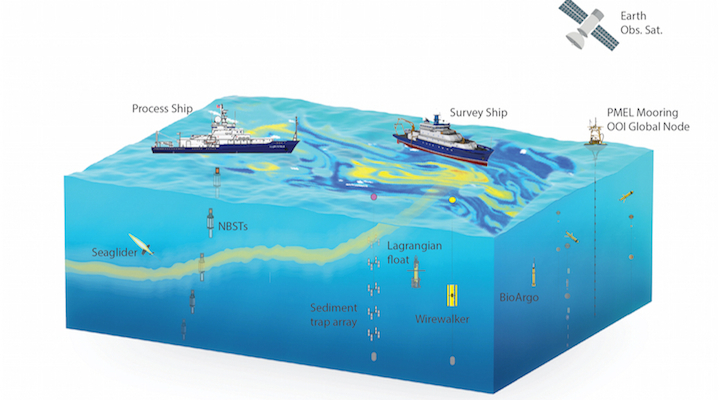Introduction to EXPORTS
Ocean ecosystems play a critical role in the Earth’s carbon cycle and the quantification of their impacts for both present conditions and for predictions into the future remains one of the greatest challenges in oceanography. The goal of the EXport Processes in the Ocean from Remote Sensing (EXPORTS) Science Plan is to develop a predictive understanding of the export and fate of global ocean net primary production (NPP) and its implications for present and future climates. The achievement of this goal requires a quantification of the mechanisms that control the export of carbon from the euphotic zone as well as its fate in the underlying “twilight zone” where some fraction of exported carbon will be sequestered in the ocean’s interior on time scales of months to millennia. In particular, data collected during EXPORTS will advance satellite diagnostic and numerical prognostic models by comparing relationships among the ecological, biogeochemical and physical oceanographic processes that control carbon cycling across a range of ecosystem and carbon cycling states. EXPORTS achieved this through a combination of ship and robotic field sampling, satellite remote sensing and numerical modeling. Through a coordinated, process-oriented approach, EXPORTS fosters new insights on ocean carbon cycling that maximizes its societal relevance through the achievement of U.S. and International research agency goals and is a key step towards our understanding of the Earth as an integrated system.
Goal
Hypothesis
Why EXPORTS?
Why Now?
Advances in Remote Sensing (& PACE!!) & autonomous tools make it time!
The EXPORTS Science Questions
NASA’s satellite ocean-color data record has revolutionized our understanding of global marine systems by providing synoptic and repeated global observations of phytoplankton stocks and rates of primary production. EXPORTS is designed to advance the utility of NASA ocean color assets to predict how changes in ocean primary production will impact the global carbon cycle. EXPORTS was put together to create a predictive understanding of both the export of organic carbon from the well-lit, upper ocean (or euphotic zone) and its fate in the underlying “twilight zone” (depths of 500 m or more) where a variable fraction of that exported organic carbon is respired back to CO2. Ultimately, it is this deep organic carbon transport and its sequestration that defines the impact of ocean biota on atmospheric CO2 levels and hence climate.
Data collected during EXPORTS generate a new, detailed understanding of ocean carbon transport processes and pathways linking phytoplankton primary production within the euphotic zone to the export and fate of produced organic matter in the underlying twilight zone using a combination of field campaigns, remote sensing and numerical modeling. NASA’s recently launched advanced ocean measurement mission, PACE, is aimed at quantifying carbon cycle processes far beyond today’s ocean color retrievals of phytoplankton pigment concentrations, optical properties and primary production rates. The overarching objective for EXPORTS was and is to ensure the success of these future satellite mission goals by establishing mechanistic relationships between remotely sensed signals and carbon cycle processes. Through a process-oriented approach, EXPORTS fosters new insights on ocean carbon cycling that will maximize its societal relevance and be a key component in the U.S. investment to understand Earth as an integrated system.
Experimental Approach
EXPORTS targeted its Science Questions by:
The EXPORTS Experimental Plan of the Moment (July 2018) is available at http://oceanexports.org/documents/NEPac_ExpPlanMomentJune12.pdf
Timeline
2021
North Atlantic Cruise - partnering with WHOI's Ocean Twilight Zone (OTZ) project and National Oceanographic Centre, Southampton2020
- April 14-17: MOB for both ships at WHOI (canceled due to COVID)
- August 18: R/V Atlantis and R/V Armstrong set sail (canceled due to COVID)
- May 31: R/V Atlantis returns to WHOI & R/V Armstrong returns to Galway Island (canceled due to COVID)
2019
2018
2017
2016
2015
2014
2013
2012
